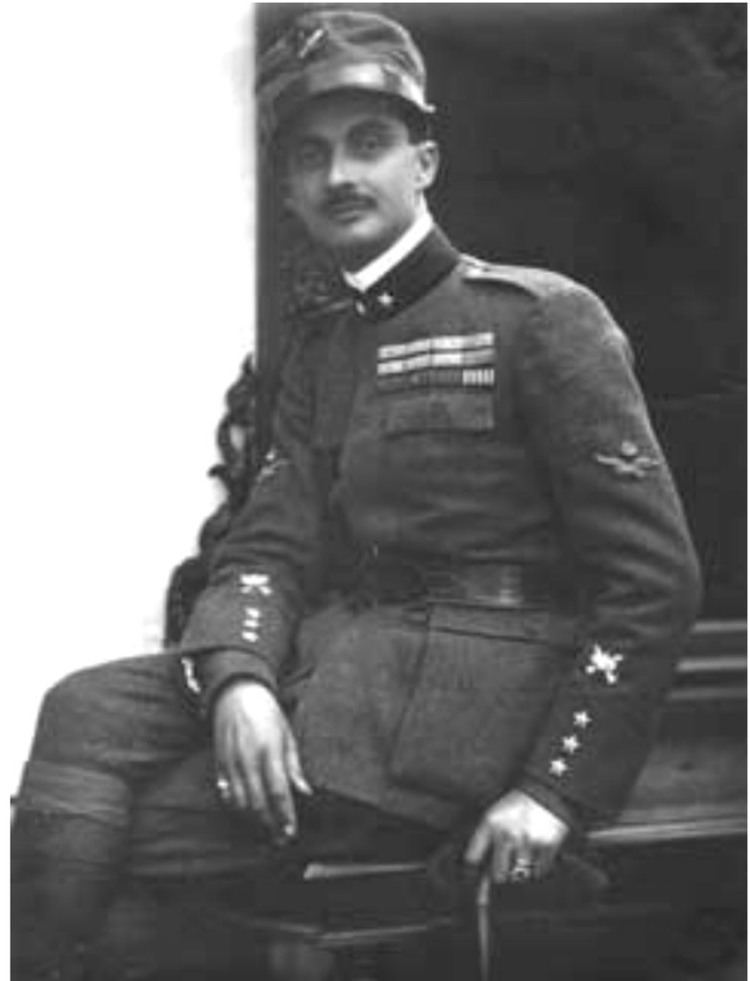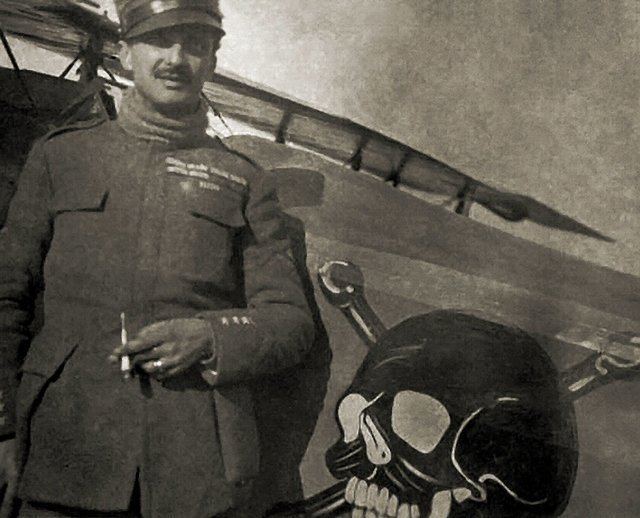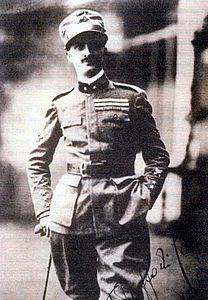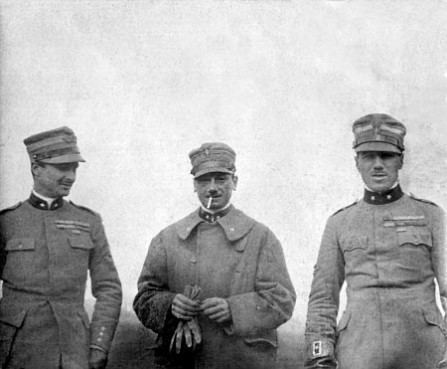Name Fulco di Children Queen Paola of Belgium | Parents Laura Mosselman du Chenoy | |
 | ||
Spouse Luisa Gazelli dei Conti di Rossana(m. 1919-46; his death) Issue Donna Maria CristinaDonna LauraPrince Fabrizio, 7th Duke of Guardia LombardaDon AugustoDonna GiovannellaDon AntonelloPaola, Queen of Belgium Father Fulco Beniamino Tristano Ruffo di Calabria, 5th Duke of Guardia Lombarda Mother Laura Mosselman du Chenoy Died August 23, 1946, Massa, Italy Grandchildren Philippe of Belgium, Princess Astrid of Belgium, Archduchess of Austria-Este, Prince Laurent of Belgium Grandparents Theodore Mosselman du Chenoy Similar People Queen Paola of Belgium, Albert II of Belgium, Philippe of Belgium, Princess Astrid of Belgium, Prince Laurent of Belgium | ||
Il restauro dello spad s vii di fulco ruffo di calabria
Fulco VIII, Prince Ruffo di Calabria, 6th Duke of Guardia Lombarda (Naples 12 August 1884 – Ronchi di Apuana 23 August 1946) was an Italian World War I flying ace, senator under the fascist regime of Benito Mussolini in World War II for which he was convicted. He was also posthumous father-in-law of King Albert II of the Belgians, and grandfather of King Philippe of Belgium.
Contents
- Il restauro dello spad s vii di fulco ruffo di calabria
- Family history
- Early life and prewar military service
- World War I service
- Post World War I service
- Awards
- Italian awards
- International awards
- Family
- References

Family history

Ademarus Rufus, who died in 1049, held the title of Comes in southern Italy. Siggerio Ruffo became Holy Roman Emperor Frederick II's grand marshal of the Kingdom of Sicily in 1235. The family divided into two branches after the 14th century: the Ruffo di Calabria and the Ruffo di Scaletta, to the former of which Fulco belonged.

Don Fulco was the son of Fulco Beniamino Tristano Ruffo di Calabria, 5th Duke of Guardia Lombarda (1848 - 1901), and Laura Mosselman du Chenoy, a Belgian aristocrat, whose maternal grandfather was Count Jacques Andre Coghen, Belgium's second finance minister. Beniamino Ruffo di Calabria was the younger brother of the head of the House of Ruffo, Fulco Ruffo di Calabria-Santapau, 10th Principe di Scilla and 2nd Duca di Santa Cristina.

Don Fulco was made, by decree of 15 March 1928, Prince Ruffo di Calabria, in the Kingdom of Italy. By inheritance he was also the 6th Duke of Guardia Lombarda and 17th Count of Sinopoli. The family Ruffo di Calabria represents one of the most ancient lineages of Italy and includes Cardinal Fabrizio Ruffo. Fulco was related to historically eminent Roman and southern Italian noble families, including the Colonna, Orsini, Pallavicini, Alliata and Rospigliosi. Among his distinguished ancestors of the French aristocracy were the Marquis de Lafayette, hero of American Independence, and the Dukes of Noailles.
Since the fall of the Italian monarchy in 1947 the Princes Ruffo di Calabria have become connected by marriage to such formerly reigning dynasties as the Orleans, the Savoys, the Bonapartes and the mediatized family of Windisch-Graetz.
Early life and prewar military service
Fulco Ruffo di Calabria was born in Naples, Kingdom of Italy on 12 August 1884. His noble family's patriotism was prominent in Italian military history since at least 1797. He thus volunteered for reserve officer's training with the 11th Foggia Light Cavalry Regiment on 22 November 1904. On 31 May 1905, he was promoted to Caporal; on 30 November, he was again promoted, to Sergente. On 20 February 1906, he was commissioned into officers' ranks as a Sottotenente. Subsequently, he became deputy director of the Belgian Wegimont shipping company's African station. He returned from Africa as World War I broke out.
World War I service
Ruffo di Calabria returned to military duty before Italy's entry into World War I, and was assigned to the Battaglione Aviatori (which later became the Corpo Aeronautico Militare on 20 December 1914. After pilot's training, on 28 September 1915, he was posted to the 4a Squadriglia Artiglia, an artillery coordination unit that later morphed into 44a Squadriglia. On 26 January 1916, he moved to 2a Squadriglia (later 42a Squadriglia). He won two Bronze awards of the Medal for Military Valor—in February and April 1916—while still a two-seater pilot with them. His personal emblem was a black skull and crossbones painted on the fuselage of his plane, whether it was his original Nieuport 11s, or his later Nieuport 17, and SPAD VII airplanes.
Ruffo di Calabria underwent further training on Nieuports at Cascina Costa in May 1916. On 26 June, he was assigned to 1a Squadriglia as a fighter pilot. He won his first victory there, shared with Francesco Baracca on 23 August 1916, and had a second one go unconfirmed. His performance was good for a Silver Medal for Military Valor in August, followed by a Bronze in September 1916.
By 16 September, when he shared a victory with Baracca and Luigi Olivari, he was scoring for his new unit, 70a Squadriglia. He ran his score with them to four confirmed and four unconfirmed by 28 February 1917.
In March 1917, he was transferred out of the reserves when he was promoted to Tenente. In May he then switched to flying a Nieuport for 91a Squadriglia. He was awarded both a Silver and a Bronze Medal for Military Valor that same month. His promotion to Capitano came through in August 1917. By that time, his confirmed victories totaled 13. He ended 1917 with his total victories at 16.
Ruffo di Calabria's records for 1918 are incomplete, but credit him with four more victories. On 5 May 1918, he was granted the ultimate Medal of Military Valor, the Gold award. After Baracca's death on 18 June 1918, Fulco assumed command of the renowned "Squadron of Aces". He relinquished command of 91a Squadriglia on 18 September to Ferruccio Ranza, after suffering a nervous breakdown. After recovery, he was handed command of 10th Gruppo, on 23 October 1918, but was shot down by artillery fire near Marano on 29 October 1918. In the end, he shot down 20 enemy airplanes in 53 combats, making him the fifth highest scoring Italian flying ace of World War I.
Post World War I service
On 1 February 1919, the Bongiovanni commission's military intelligence report verified all 20 of Ruffo di Calabria's confirmed victories, though still denying the five that were unconfirmed. Di Calabria remained in the military, though without assignment. By 1925, his main activity was management of his family estates located near Paliano.
In 1934 he was named senator of the kingdom by king Victor Emmanuel III. He also continued in the military, eventually rising to the rank of Tenente Colonello in 1942. Ruffo di Calabria served in the Italian senate until 1944.
During World War II he was a supporter of the Italian fascist leader Mussolini. He was subsequently convicted postwar by an Italian court for complicity in the crimes of fascism, and that ruling was upheld on 10 January 1946 despite his appeal.
Fulco Ruffo di Calabria died in Ronchi di Apuania, Italy on 23 August 1946.
Awards
Ruffo Di Calabria was awarded the following distinctions:
Italian awards
International awards
He also served as a senator.
Family
On 30 June 1919 he married, in Turin, Luisa Gazelli (1896–1989), daughter of Augusto Gazelli dei Conti di Rossana, and of Maria Cristina dei Conti Rignon. Luisa served as a lady-in-waiting at the Italian court.
They had seven children:
